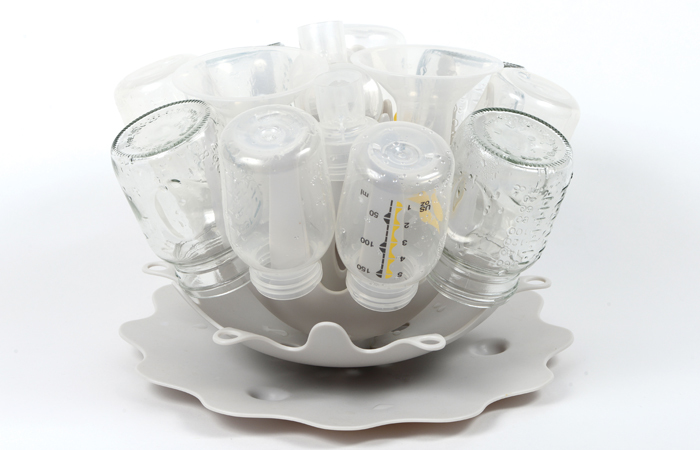3. Sterilisation
In Equipment
Follow this topic
Bookmark
Record learning outcomes
Babies are most vulnerable to infections during their first year of life and as milk provides a perfect medium for the growth of bacteria, it is essential that bottle feeding equipment is sterilised for the first year
Before sterilising, all equipment should be washed in a dishwasher or in hot, soapy water, with bottles scrubbed inside and out with a bottle brush. Teats should be scrubbed and cleaned with a teat brush and water squirted through them to remove all traces of milk. For mums who are expressing breast milk, the parts of the breast pump that come into contact with milk (e.g. suction cup) will also need to be sterilised before use. All equipment should then be rinsed in water before sterilising.

 Important
Important
If sterilised bottles are not being used immediately, they should be fully assembled and used within 24 hours to prevent contamination.
Sterilisation methods
There are three main methods of sterilising: cold water, electric steam and microwave.
Cold water sterilising
1 Following the manufacturer’s instructions, fill the steriliser with water and add the sterilising liquid or tablets.
2 Completely immerse the equipment in the steriliser using the float tray to ensure it is totally submerged and there are no trapped air bubbles.
3 Replace the lid and leave for at least 30 minutes (or as per the manufacturer’s instructions).
4 Rinse items with cooled, boiled water before use, if necessary.
5 Change the sterilising solution every 24 hours.
Electric steam/microwave sterilising
These are the fastest methods of sterilising and require no tablets, liquid or rinsing of items. They are more expensive to buy and may require regular de-scaling. Some microwave sterilisers don’t hold as many bottles as electric versions.
1 Following the manufacturer’s instructions, add the required amount of water to the steriliser.
2 Ensure that all of the bottle and teat openings are facing downwards in the steriliser so that they do not fill with water.
3 Replace the lid.
4 For electric steam sterilisers, simply switch on. For microwave sterilisers, place in the microwave using the correct power setting for the required amount of time.
5 Allow the contents to cool slightly before opening the lid. Refer to the manufacturer’s guidelines to see how long equipment will be sterile for.
6 Steam sterilisers need de-scaling, on average once a month, depending on the hardness of the water. Microwave sterilisers may require occasional de-scaling.
Steam sterilising: an example of on-pack instructions
 1 Wash hands thoroughly and wash the feeding equipment in hot, soapy water. Scrub the insides and outsides of the bottles using a bottle brush. Scrub the teats with a teat brush and squirt water through them to help remove all traces of milk. Rinse all equipment thoroughly under the tap.
1 Wash hands thoroughly and wash the feeding equipment in hot, soapy water. Scrub the insides and outsides of the bottles using a bottle brush. Scrub the teats with a teat brush and squirt water through them to help remove all traces of milk. Rinse all equipment thoroughly under the tap.
2 Add the required amount of water to the steriliser (see manufacturer’s instructions).
3 Load the steriliser with the equipment, including the teat tongs (making sure that no items are facing upwards/able to fill with water). Put the lid on the steriliser and either switch it on or put it in the microwave on the required power and time setting (see manufacturer’s instructions).
4 When it has finished, the steriliser will usually turn itself off. Keep the lid on the steriliser and allow the contents to cool slightly before opening.
5 Always assemble the bottles using the sterilised teat tongs to avoid contaminating the sterile equipment. If not being used immediately, bottles should be fully assembled with teats and lids in place. Use bottles within 24 hours (see manufacturer’s instructions, as this may vary).
